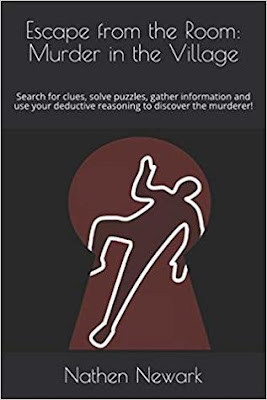Home-made (in more than one way)
  |
Publisher:
Self-Published (https://escapefromtheroom.co.uk/)
Author:
Nathen Newark
Illustrator:
Joseph Newark
# of Players:
1
Game Design & Mechanics
- "Escape From the Room" is a UK-based company that's been around since 2016. "The Curse of Old Maid Milly" was their very first room, set in an actual bedroom, in the founder's real house. Since then, the company has grown to three locations and half a dozen rooms. That same founder also created two book adaptations of his earlier rooms, the very books discussed here.
- Every "double page" is numbered. A typical page will give you a little bit of story, and some general directions for your next puzzle. With the answer to that puzzle, you'll be able to extract a two-digit number telling you which page to go to next.
- Worried of being bored by repeated two-digit answers? Actually, puzzle answers can be numbers and words of any length, or even compass directions. A conversion table is used to convert such answers into digits. Likewise, square blocks at the end of each page will clearly show you how many letters / digits your answer should have, and highlight which ones to pick to get your next page number. Finally, every page clearly states which page you should be arriving from, so you can't get lost along the way.
- A few pages are set specifically for search purposes. You'll be referred to them through some mechanism (typically a room map), and then you'll be able to consult those pages at your leisure.
- Inventory management is simple, yet efficient. Along your way, you'll be instructed to add a few bold items to your inventory list. Later on, you might be asked to find the right item to use, out of that list.
- There are both hints and solutions made available on the company's website.
Pros
- The game mechanics found in these books make a pretty great job at simulating an escape room. The map and inventory system are simple, yet efficient, and I didn't really mind the linearity of the puzzles.
- There are plenty of puzzles, and those feel quite varied, especially thanks to the "code conversion table".
Cons
- The story (Old Maid Milly's, at least) didn't really engage me. I think Mr. Newark is a good puzzle designer, but getting an editor might have made for a better tale.
- Likewise, the illustrations aren't particularly impressive either. I suspect the books could have become more popular if they caught the eye as much as the French ones I've previously reviewed.
- While the hints given online seem reasonable, the answers can be very "dry". (ex: "The code is 1234, go to page 23") I got completely stuck twice, and had to ask around online for some proper explanations of what the solutions actually were.
Errata
- In the first printing (2017) of The Curse of Old Maid Milly, something's missing from your inventory. If you own such a copy, you'll need to add this to your starting inventory: .
Currently Out (underline bold titles are those I've read personally)
- The Curse of Old Maid Milly
- Murder in the Village
- The Challenger Chamber
























